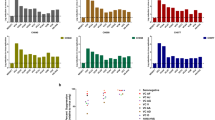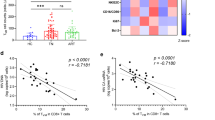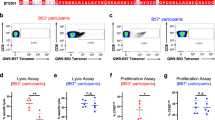Abstract
The human leukocyte antigens HLA-B*27 and HLA-B*57 are associated with protection against progression of disease that results from infection with human immunodeficiency virus type 1 (HIV-1), yet most people with alleles encoding HLA-B*27 and HLA-B*57 are unable to control HIV-1. Here we found that HLA-B*27-restricted CD8+ T cells in people able to control infection with HIV-1 (controllers) and those who progress to disease after infection with HIV-1 (progressors) differed in their ability to inhibit viral replication through targeting of the immunodominant epitope of group-associated antigen (Gag) of HIV-1. This was associated with distinct T cell antigen receptor (TCR) clonotypes, characterized by superior control of HIV-1 replication in vitro, greater cross-reactivity to epitope variants and enhanced loading and delivery of perforin. We also observed clonotype-specific differences in antiviral efficacy for an immunodominant HLA-B*57-restricted response in controllers and progressors. Thus, the efficacy of such so-called 'protective alleles' is modulated by specific TCR clonotypes selected during natural infection, which provides a functional explanation for divergent HIV-1 outcomes.
This is a preview of subscription content, access via your institution
Access options
Subscribe to this journal
Receive 12 print issues and online access
$209.00 per year
only $17.42 per issue
Buy this article
- Purchase on Springer Link
- Instant access to full article PDF
Prices may be subject to local taxes which are calculated during checkout







Similar content being viewed by others
References
Migueles, S.A. & Connors, M. Long-term nonprogressive disease among untreated HIV-infected individuals. J. Am. Med. Assoc. 304, 194–201 (2010).
Deeks, S.G. & Walker, B.D. Human immunodeficiency virus controllers: mechanisms of durable virus control in the absence of antiretroviral therapy. Immunity 27, 406–416 (2007).
Kaslow, R.A. et al. Influence of combinations of human major histocompatibility complex genes on the course of HIV-1 infection. Nat. Med. 2, 405–411 (1996).
Migueles, S.A. et al. HLA B*5701 is highly associated with restriction of virus replication in a subgroup of HIV-infected long term nonprogressors. Proc. Natl. Acad. Sci. USA 97, 2709–2714 (2000).
Carrington, M. & O'Brien, S.J. The influence of HLA genotype on AIDS. Annu. Rev. Med. 54, 535–551 (2003).
Pereyra, F. et al. The major genetic determinants of HIV-1 control affect HLA class I peptide presentation. Science 330, 1551–1557 (2010).
Betts, M.R. et al. Analysis of total human immunodeficiency virus (HIV)-specific CD4+ and CD8+ T-cell responses: relationship to viral load in untreated HIV infection. J. Virol. 75, 11983–11991 (2001).
Addo, M.M. et al. Comprehensive epitope analysis of human immunodeficiency virus type 1 (HIV-1)-specific T-cell responses directed against the entire expressed HIV-1 genome demonstrate broadly directed responses, but no correlation to viral load. J. Virol. 77, 2081–2092 (2003).
Betts, M.R. et al. HIV nonprogressors preferentially maintain highly functional HIV-specific CD8+ T cells. Blood 107, 4781–4789 (2006).
Almeida, J.R. et al. Antigen sensitivity is a major determinant of CD8+ T-cell polyfunctionality and HIV-suppressive activity. Blood 113, 6351–6360 (2009).
Bennett, M.S., Ng, H.L., Dagarag, M., Ali, A. & Yang, O.O. Epitope-dependent avidity thresholds for cytotoxic T-lymphocyte clearance of virus-infected cells. J. Virol. 81, 4973–4980 (2007).
Migueles, S.A. et al. HIV-specific CD8+ T cell proliferation is coupled to perforin expression and is maintained in nonprogressors. Nat. Immunol. 3, 1061–1068 (2002).
Migueles, S.A. et al. Lytic granule loading of CD8+ T cells is required for HIV-infected cell elimination associated with immune control. Immunity 29, 1009–1021 (2008).
Hersperger, A.R. et al. Perforin expression directly ex vivo by HIV-specific CD8 T-cells is a correlate of HIV elite control. PLoS Pathog. 6, e1000917 (2010).
Dahirel, V. et al. Coordinate linkage of HIV evolution reveals regions of immunological vulnerability. Proc. Natl. Acad. Sci. USA 108, 11530–11535 (2011).
Kiepiela, P. et al. CD8+ T-cell responses to different HIV proteins have discordant associations with viral load. Nat. Med. 13, 46–53 (2007).
Elahi, S. et al. Protective HIV-specific CD8+ T cells evade Treg cell suppression. Nat. Med. 17, 989–995 (2011).
Kaufmann, D.E. et al. Upregulation of CTLA-4 by HIV-specific CD4+ T cells correlates with disease progression and defines a reversible immune dysfunction. Nat. Immunol. 8, 1246–1254 (2007).
Day, C.L. et al. PD-1 expression on HIV-specific T cells is associated with T-cell exhaustion and disease progression. Nature 443, 350–354 (2006).
Pérez, C.L. et al. Broadly immunogenic HLA class I supertype-restricted elite CTL epitopes recognized in a diverse population infected with different HIV-1 subtypes. J. Immunol. 180, 5092–5100 (2008).
Miura, T. et al. HLA-B57/B*5801 human immunodeficiency virus type 1 elite controllers select for rare Gag variants associated with reduced viral replication capacity and strong cytotoxic T-lymphotye recognition. J. Virol. 83, 2743–2755 (2009).
Lassen, K.G. et al. Elite suppressor derived HIV-1 envelope glycoproteins exhibit reduced entry efficiency and kinetics. PLoS Pathog. 5, e1000377 (2009).
Goulder, P.J. et al. Late escape from an immunodominant cytotoxic T-lymphocyte response associated with progression to AIDS. Nat. Med. 3, 212–217 (1997).
Lee, K.-H. et al. The immunological synapse balances T cell receptor signaling and degradation. Science 302, 1218–1222 (2003).
Kosmrlj, A. et al. Effects of thymic selection of the T-cell repertoire on HLA class I-associated control of HIV infection. Nature 465, 350–354 (2010).
Pereyra, F. et al. Genetic and immunologic heterogeneity among persons who control HIV infection in the absence of therapy. J. Infect. Dis. 197, 563–571 (2008).
Goulder, P.J. et al. Evolution and transmission of stable CTL escape mutations in HIV infection. Nature 412, 334–338 (2001).
Almeida, J.R. et al. Superior control of HIV-1 replication by CD8+ T cells is reflected by their avidity, polyfunctionality, and clonal turnover. J. Exp. Med. 204, 2473–2485 (2007).
Mendoza, D. et al. HLA B*5701+ long-term nonprogressors/elite controllers are not distinguished from progressors by the clonal composition of HIV-specific CD8+ T-cells. J. Virol. 86, 4014–4018 (2012).
van Bockel, D.J. et al. Persistent survival of prevalent clonotypes within an immunodominant HIV Gag-specific CD8+ T cell response. J. Immunol. 186, 359–371 (2011).
Iglesias, M.C. et al. Escape from highly effective public CD8+ T-cell clonotypes by HIV. Blood 118, 2138–2149 (2011).
Day, C.L. et al. Proliferative capacity of epitope-specific CD8 T-cell responses is inversely related to viral load in chronic human immunodeficiency virus type 1 infection. J. Virol. 81, 434–438 (2007).
Champagne, P. et al. Skewed maturation of memory HIV-specific CD8 T lymphocytes. Nature 410, 106–111 (2001).
Hamann, D.r. et al. Phenotypic and functional separation of memory and effector human CD8+ T cells. J. Exp. Med. 186, 1407–1418 (1997).
Brockman, M.A., Tanzi, G.O., Walker, B.D. & Allen, T.M. Use of a novel GFP reporter cell line to examine replication capacity of CXCR4- and CCR5-tropic HIV-1 by flow cytometry. J. Virol. Methods 131, 134–142 (2006).
Schneidewind, A. et al. Structural and functional constraints limit options for cytotoxic T-lymphocyte escape in the immunodominant HLA-B27-restricted epitope in human immunodeficiency virus type 1 capsid. J. Virol. 82, 5594–5605 (2008).
Chen, H. et al. Differential neutralization of human immunodeficiency virus (HIV) replication in autologous CD4 T cells by HIV-specific cytotoxic T lymphocytes. J. Virol. 83, 3138–3149 (2009).
Julg, B. et al. Infrequent recovery of HIV from but robust exogenous infection of activated CD4+ T cells in HIV elite controllers. Clin. Infect. Dis. 51, 233–238 (2010).
Miles, J.J., Douek, D.C. & Price, D.A. Bias in the αβ T-cell repertoire: implications for disease pathogenesis and vaccination. Immunol. Cell Biol. 89, 375–387 (2011).
Liu, D. et al. Integrin-dependent organization and bidirectional vesicular traffic at cytotoxic immune synapses. Immunity 31, 99–109 (2009).
Stewart-Jones, G.B.E. et al. Crystal structures and KIR3DL1 recognition of three immunodominant viral peptides complexed to HLA-B*2705. Eur. J. Immunol. 35, 341–351 (2005).
Price, D.A. et al. Public clonotype usage identifies protective Gag-specific CD8+ T cell responses in SIV infection. J. Exp. Med. 206, 923–936 (2009).
Dong, T. et al. HIV-specific cytotoxic T cells from long-term survivors select a unique T cell receptor. J. Exp. Med. 200, 1547–1557 (2004).
Venturi, V. et al. A mechanism for TCR sharing between T cell subsets and individuals revealed by pyrosequencing. J. Immunol. 186, 4285–4294 (2011).
Miura, T. et al. Genetic characterization of human immunodeficiency virus type 1 in elite controllers: lack of gross genetic defects or common amino acid changes. J. Virol. 82, 8422–8430 (2008).
Allen, T.M. et al. Selection, transmission, and reversion of an antigen-processing cytotoxic T-lymphocyte escape mutation in human immunodeficiency virus type 1 infection. J. Virol. 78, 7069–7078 (2004).
Walker, B.D. et al. Long-term culture and fine specificity of human cytotoxic T-lymphocyte clones reactive with human immunodeficiency virus type 1. Proc. Natl. Acad. Sci. USA 86, 9514–9518 (1989).
Varadarajan, N. et al. A high-throughput single-cell analysis of human CD8+ T cell functions reveals discordance for cytokine secretion and cytolysis. J. Clin. Invest. 121, 4322–4331 (2011).
Yang, O.O. et al. Impacts of avidity and specificity on the antiviral efficiency of HIV-1-specific CTL. J. Immunol. 171, 3718–3724 (2003).
Wilson, C.C. et al. Ex vivo expansion of CD4 lymphocytes from human immunodeficiency virus type 1-infected persons in the presence of combination antiretroviral agents. J. Infect. Dis. 172, 88–96 (1995).
Acknowledgements
We thank J. Wong (Massachusetts General Hospital) for monoclonal antibody 12F6 to CD3 and monoclonal antibody CD3:8 bispecific for CD3 and CD8; and all study participants for their contributions. Supported by the Harvard University Center for AIDS Research (5 P30 AI060354-04), the Bill and Melinda Gates Foundation (B.D.W. and D.C.D.), the Doris Duke Charitable Foundation (B.D.W.), the US National Institutes of Health (AI030914 to B.D.W. and AI074415 to T.M.A.), the Howard Hughes Medical Institute (B.D.W.), the Mark and Lisa Schwartz Foundation (B.D.W.), the Intramural Research Program and the Office of AIDS Research of the US National Institutes of Health (D.C.D. and S.D.), the Canadian Institutes for Health Research (New Investigator Award to Z.L.B.) and the Canada Research Chair in Viral Pathogenesis and Immunity (M.A.B.).
Author information
Authors and Affiliations
Contributions
H.C. was responsible for the overall conduct of the study, under the supervision of B.D.W.; H.C., Z.M.N. and B.D.W. contributed to the experimental design; H.C., Z.M.N., L.C.P. and J.W.F. did the experiments and analyzed the data; S.D. and D.C.D. did germline analyses; T.M., Z.L.B., K.T.C. and J.S. did virus sequencing; M.A.B., A.S. and T.M.A. constructed HIV-1 variants and GXR cell lines; D.L. and D.E.K. did the imaging experiments; T.D.C. and X.G.Y. helped with TCR sequencing; F.P., A.P.-T. and I.T. provided clinical samples; and H.C., Z.M.N. and B.D.W. wrote the paper and all authors contributed to revisions.
Corresponding author
Ethics declarations
Competing interests
The authors declare no competing financial interests.
Supplementary information
Supplementary Text and Figures
Supplementary Figures 1–6 (PDF 237 kb)
Rights and permissions
About this article
Cite this article
Chen, H., Ndhlovu, Z., Liu, D. et al. TCR clonotypes modulate the protective effect of HLA class I molecules in HIV-1 infection. Nat Immunol 13, 691–700 (2012). https://doi.org/10.1038/ni.2342
Received:
Accepted:
Published:
Issue Date:
DOI: https://doi.org/10.1038/ni.2342
This article is cited by
-
HIV specific Th1 responses are altered in Ugandans with HIV and Schistosoma mansoni coinfection
BMC Immunology (2023)
-
Immunogenic arenavirus vector SIV vaccine reduces setpoint viral load in SIV-challenged rhesus monkeys
npj Vaccines (2023)
-
A longitudinal analysis of immune escapes from HLA-B*13-restricted T-cell responses at early stage of CRF01_AE subtype HIV-1 infection and implications for vaccine design
BMC Immunology (2022)
-
HIV-2 Vpx neutralizes host restriction factor SAMHD1 to promote viral pathogenesis
Scientific Reports (2021)
-
Immunologic Control of HIV-1: What Have We Learned and Can We Induce It?
Current HIV/AIDS Reports (2021)



